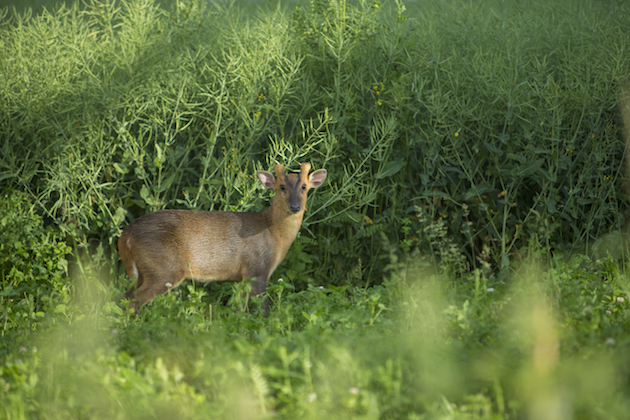All about muntjac
Small, secretive and constantly on the move, the muntjac is a challenging quarry for the deer stalker. Little bigger than…
Win CENS ProFlex DX5 earplugs worth £1,149 – enter here
Learning how to call muntjac deer can be a deadly tactic but you need a strategy, stealth and a good call, writes Graham Downing

Hunters have been ‘calling’ their quarry for as long as hunting has existed.
Wildfowlers call duck and geese, fox shooters call foxes and, of course, German roe stalkers long ago elevated calling roebucks in the rut to an art form.
But it is not just roe that can be called to the deerstalker’s rifle. For tens of thousands of years, muntjac evolved in the dense forests of south-east Asia, so it is not surprising that communication by sound is central to their way of life.
We all know the muntjac’s ‘bark’. However, it is not the bark that is of value in calling this little deer, but the rather plaintive bleat or squeal made by the muntjac fawn when it is threatened by danger.
Adult muntjac are feisty in defence of their offspring, and if they should hear a fawn in distress, then they will come to challenge and see off whatever it is that is threatening their young.
Muntjac breed all year round so calling works from autumn right through to high summer. However it is in the autumn and winter months, when the woodland ground cover is thinnest, that muntjac are easiest to spot.
Both bucks and does will come to a call, and the strategy may be successful at any time of day: muntjac can be called in the morning, evening and during the middle of the day, though I have had my most consistent results an hour or so after sunrise, when I occasionally try to convert a blank morning into a successful one by spending some time calling.
Nor is success with a call restricted to ground-level operations. Calling from a high seat can be very effective indeed and when it works, it is tremendously exciting.
You can call a muntjac with a blade of grass stretched between two cupped hands but a commercial call has more consistent results. The best I have found is the good old stalker’s standby, the Buttolo. It gives the ‘bleat’ note that the muntjac stalker is after.
The note can be varied between a weak and pathetic bleat and a rather more urgent squeal, and likewise the sound level can be altered by holding the call in the open for maximum volume and cupping it in your hand or holding it in your pocket to mute the note.
Small, secretive and constantly on the move, the muntjac is a challenging quarry for the deer stalker. Little bigger than…
Ignore photographs of foreigners using air rifles to shoot Mubtjac rifles because this is illegal in Britain, George advises
Get the latest news delivered direct to your door
Discover the ultimate companion for field sports enthusiasts with Shooting Times & Country Magazine, the UK’s leading weekly publication that has been at the forefront of shooting culture since 1882. Subscribers gain access to expert tips, comprehensive gear reviews, seasonal advice and a vibrant community of like-minded shooters.
Save on shop price when you subscribe with weekly issues featuring in-depth articles on gundog training, exclusive member offers and access to the digital back issue library. A Shooting Times & Country subscription is more than a magazine, don’t just read about the countryside; immerse yourself in its most authoritative and engaging publication.

